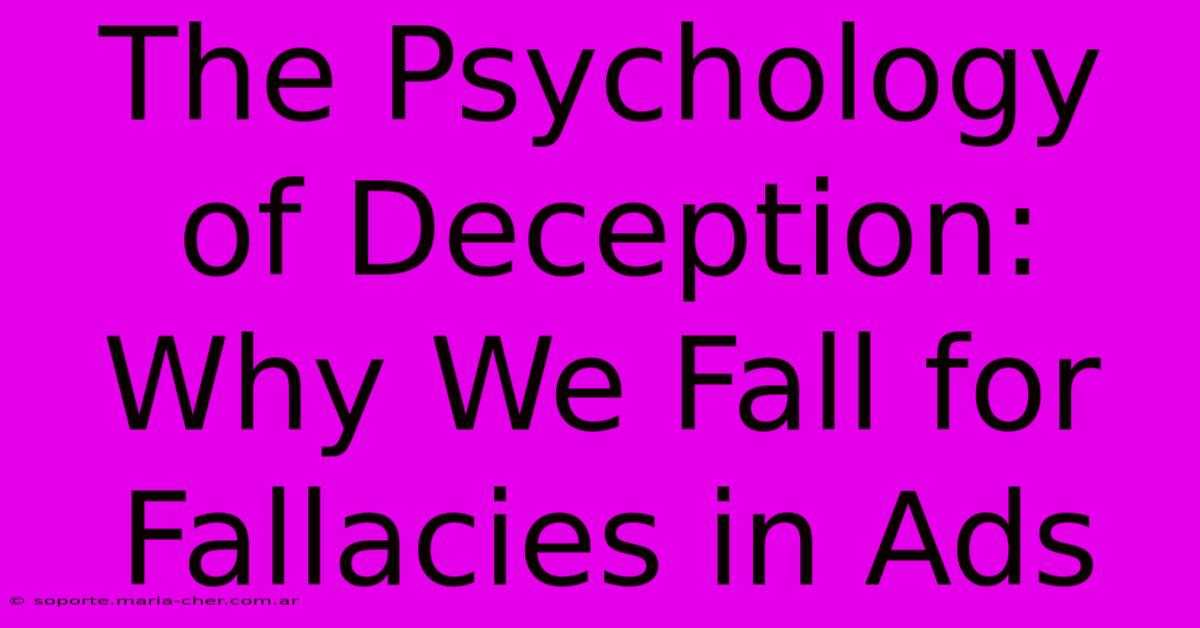The Psychology Of Deception: Why We Fall For Fallacies In Ads

Table of Contents
The Psychology of Deception: Why We Fall for Fallacies in Ads
Advertising is a powerful force shaping our desires and spending habits. But how often do we fall prey to manipulative advertising techniques that prey on our psychological vulnerabilities? Understanding the psychology behind deceptive advertising is crucial to becoming a more discerning consumer. This article delves into the common fallacies used in advertising and explores the psychological mechanisms that make us susceptible to them.
The Power of Persuasion: Cognitive Biases at Play
Our brains are not perfectly rational processors of information. We're prone to cognitive biases – systematic errors in thinking that can lead us to make irrational decisions. Advertisers cleverly exploit these biases to manipulate our choices.
1. Anchoring Bias: The First Impression Matters
The anchoring bias refers to our tendency to rely heavily on the first piece of information we receive (the "anchor") when making decisions. Advertisers often use this by initially presenting a high price, then offering a seemingly discounted price that looks incredibly appealing in comparison. This creates a false sense of value.
2. Bandwagon Effect: Following the Crowd
The bandwagon effect describes our inclination to believe something is good or desirable simply because many others believe it. Ads frequently showcase popularity – "millions sold!" or "most-loved brand!" – to leverage this bias and encourage us to join the perceived majority.
3. Confirmation Bias: Seeing What We Want to See
Confirmation bias is the tendency to search for, interpret, favor, and recall information that confirms or supports one's prior beliefs or values. Clever ads play on this by highlighting information that reinforces our existing desires or preconceived notions about a product, ignoring potential downsides.
4. Scarcity Principle: Limited-Time Offers & FOMO
The scarcity principle exploits our fear of missing out (FOMO). Limited-time offers, limited-stock announcements, and exclusivity create a sense of urgency, pressuring us to buy before it's too late, regardless of whether we truly need the product.
5. Halo Effect: Positive Associations
The halo effect refers to the tendency to let one positive trait influence our overall opinion. Advertisers associate their products with positive images, celebrities, or lifestyles, hoping this positive association will transfer to their brand, regardless of the product's actual merits.
Deceptive Advertising Techniques: Beyond Cognitive Biases
Beyond exploiting our cognitive biases, advertisers employ various deceptive techniques:
- Hidden Fees: The advertised price might not include taxes, shipping, or other hidden costs, making the final price significantly higher than expected.
- Exaggerated Claims: Ads often use superlatives and hyperbolic language to inflate the product's benefits, often without concrete evidence.
- Misleading Visuals: Images and videos can be manipulated to create a false impression of the product's quality, size, or function.
- Emotional Appeals: Advertisers tap into our emotions – fear, joy, love, desire – to create a strong connection with the product, bypassing rational evaluation.
Becoming a More Discerning Consumer: Fighting Back Against Deception
Protecting ourselves from manipulative advertising requires critical thinking and awareness. Here are some strategies:
- Question the Claims: Don't accept claims at face value. Look for independent reviews, compare prices, and examine the evidence supporting the advertised benefits.
- Be Aware of Emotional Appeals: Recognize when ads are playing on your emotions rather than presenting factual information.
- Compare Prices and Features: Don't be swayed by flashy marketing. Compare prices and features from different brands to find the best value.
- Read the Fine Print: Pay close attention to the small details, including hidden fees, terms and conditions, and disclaimers.
- Be Skeptical: Maintain a healthy dose of skepticism when encountering persuasive advertising.
By understanding the psychology of deception and employing these strategies, we can navigate the world of advertising more effectively and make more informed purchasing decisions. The power of persuasion is strong, but with critical awareness, we can resist its manipulative tactics.

Thank you for visiting our website wich cover about The Psychology Of Deception: Why We Fall For Fallacies In Ads. We hope the information provided has been useful to you. Feel free to contact us if you have any questions or need further assistance. See you next time and dont miss to bookmark.
Featured Posts
-
Warning Dont Let These Ad Fallacies Sway Your Purchase Decisions
Feb 07, 2025
-
Nature Photographers Dream Sony Alpha 300 Dslr For Capturing Wildlifes Majesty
Feb 07, 2025
-
Elevate Your Space Saddle Stitched Wall Calendars For The Modern Home
Feb 07, 2025
-
Unmasking The Masters Of Manipulation Fake Ads That Tricked The World
Feb 07, 2025
-
Hacking Higher Ed Gen Zs Guide To Crushing College And Beyond
Feb 07, 2025
